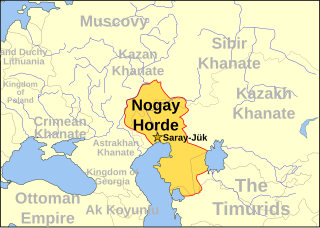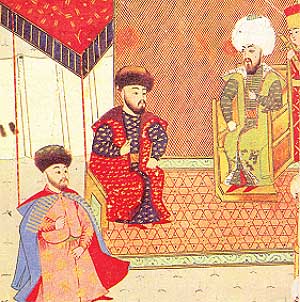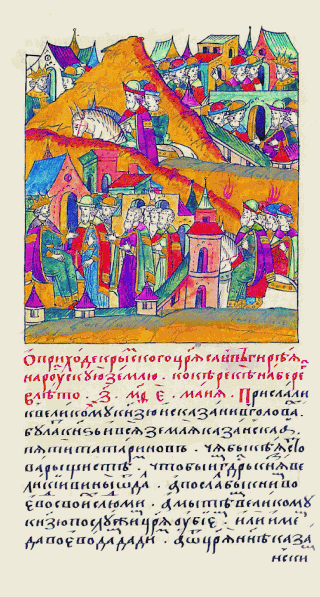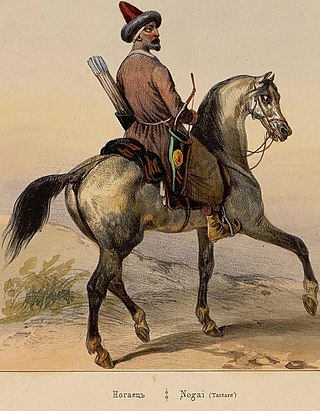
The Tatars is an umbrella term for different Turkic ethnic groups bearing the name "Tatar". Initially, the ethnonym Tatar possibly referred to the Tatar confederation. That confederation was eventually incorporated into the Mongol Empire when Genghis Khan unified the various steppe tribes. Historically, the term Tatars was applied to anyone originating from the vast Northern and Central Asian landmass then known as Tartary, a term which was also conflated with the Mongol Empire itself. More recently, however, the term has come to refer more narrowly to related ethnic groups who refer to themselves as Tatars or who speak languages that are commonly referred to as Tatar.

The Golden Horde, self-designated as Ulug Ulus, lit. 'Great State' in Turkic, was originally a Mongol and later Turkicized khanate established in the 13th century and originating as the northwestern sector of the Mongol Empire. With the disintegration of the Mongol Empire after 1259, it became a functionally separate khanate. It is also known as the Kipchak Khanate or as the Ulus of Jochi, and it replaced the earlier, less organized Cuman–Kipchak confederation.

The Khanate of Kazan was a medieval Tatar Turkic state that occupied the territory of former Volga Bulgaria between 1438 and 1552. The khanate covered contemporary Tatarstan, Mari El, Chuvashia, Mordovia, and parts of Udmurtia and Bashkortostan; its capital was the city of Kazan. It was one of the successor states of the Golden Horde, and it came to an end when it was conquered by the Tsardom of Russia.

The Crimean Khanate, self defined as the Throne of Crimea and Desht-i Kipchak, and in old European historiography and geography known as Little Tartary, was a Crimean Tatar state existing from 1441 to 1783, the longest-lived of the Turkic khanates that succeeded the empire of the Golden Horde. Established by Hacı I Giray in 1441, it was regarded as the direct heir to the Golden Horde and to Desht-i-Kipchak.
Hacı I Giray was the founder of the Crimean Khanate and the Giray dynasty of Crimea. As the Golden Horde was breaking up, he established himself in Crimea and spent most of his life fighting off other warlords. He was usually allied with the Lithuanians. His name has many spellings, such as Haji-Girei and Melek Haji Girai.

Devlet I Giray was a Crimean Khan. His long and eventful reign saw many highly significant historical events: the fall of Kazan to Russia in 1552, the fall of the Astrakhan Khanate to Russia in 1556, the burning of Moscow at the hands of the Crimean Tatars in 1571 and the defeat of the Crimeans near Moscow in 1572. During Devlet's reign there were a number of Cossack raids on Crimea.

The Nogai Horde was a confederation founded by the Nogais that occupied the Pontic–Caspian steppe from about 1500 until they were pushed west by the Kalmyks and south by the Russians in the 17th century. The Mongol tribe called the Manghuds constituted a core of the Nogai Horde.

The Great Horde was a rump state of the Golden Horde that existed from the mid-15th century to 1502. It was centered at the core of the Golden Horde at Sarai. Both the Khanate of Astrakhan and the Khanate of Crimea broke away from the Great Horde throughout its existence, and were hostile to the Great Horde. The defeat of the forces of the Great Horde at the Great Stand on the Ugra River by Ivan III of Russia marked the end of the "Tatar yoke" over Russia.
Meñli I Giray (1445–1515), also spelled as Mengli I Giray, was a khan of the Crimean Khanate and the sixth son of Hacı I Giray.

Mehmed I Giray was khan of the Crimean Khanate. He was preceded by his father Meñli I Giray and followed by his son Ğazı I Giray (1523–1524). He gained control of the steppe nomads, put his brother on the throne of Kazan and was killed after taking Astrakhan.

Sahib I Giray (1501–1551) was Khan of Kazan for three years and Khan of Crimea for nineteen years. His father was the Crimean Khan Meñli I Giray. Sahib was placed on the throne of Kazan by his ambitious brother Mehmed of Crimea and driven out of Kazan by the Russians. He became Khan of Crimea with Ottoman support and was expelled by the Turks for disobedience. During his reign Crimean troops fought for the Turks and also fought in the North Caucasus. In 1532-1584, during the long reigns of Sahib I Giray, Devlet I Giray and Mehmed II Giray, Crimea was at the height of its power.

The steppe and forest-steppe of Ukraine and southern Russia is good agricultural land, but it was traditionally held by pastoral nomads. Any state that could drive off the nomads and fill the land with tax-paying peasants would expand its power enormously. During the period 1500–1800, this region was taken under Russian control.
Sheikh Ahmed was the last Khan of the Great Horde, a remnant of the Golden Horde.

The Nogais are a Turkic ethnic group who live in the North Caucasus region. Most are found in Northern Dagestan and Stavropol Krai, as well as in Karachay-Cherkessia and Astrakhan Oblast; some also live in Chechnya, Dobruja, Turkey, Kazakhstan, Uzbekistan, Ukraine and a small Nogai diaspora is found in Jordan. They speak the Nogai language and are descendants of various Mongolic and Turkic tribes who formed the Nogai Horde. There are seven main groups of Nogais: the Ak Nogai, the Karagash, the Kuban-Nogai, the Kundraw-Nogai, the Qara-Nogai, the Utars and the Yurt-Nogai.

Ahmed Khan bin Küchük was a Khan of the Great Horde between 1465 and 1481.
Nur Devlet, was a khan of the Crimean Khanate and the son of Hacı I Giray, the founder of Crimean Khanate.














